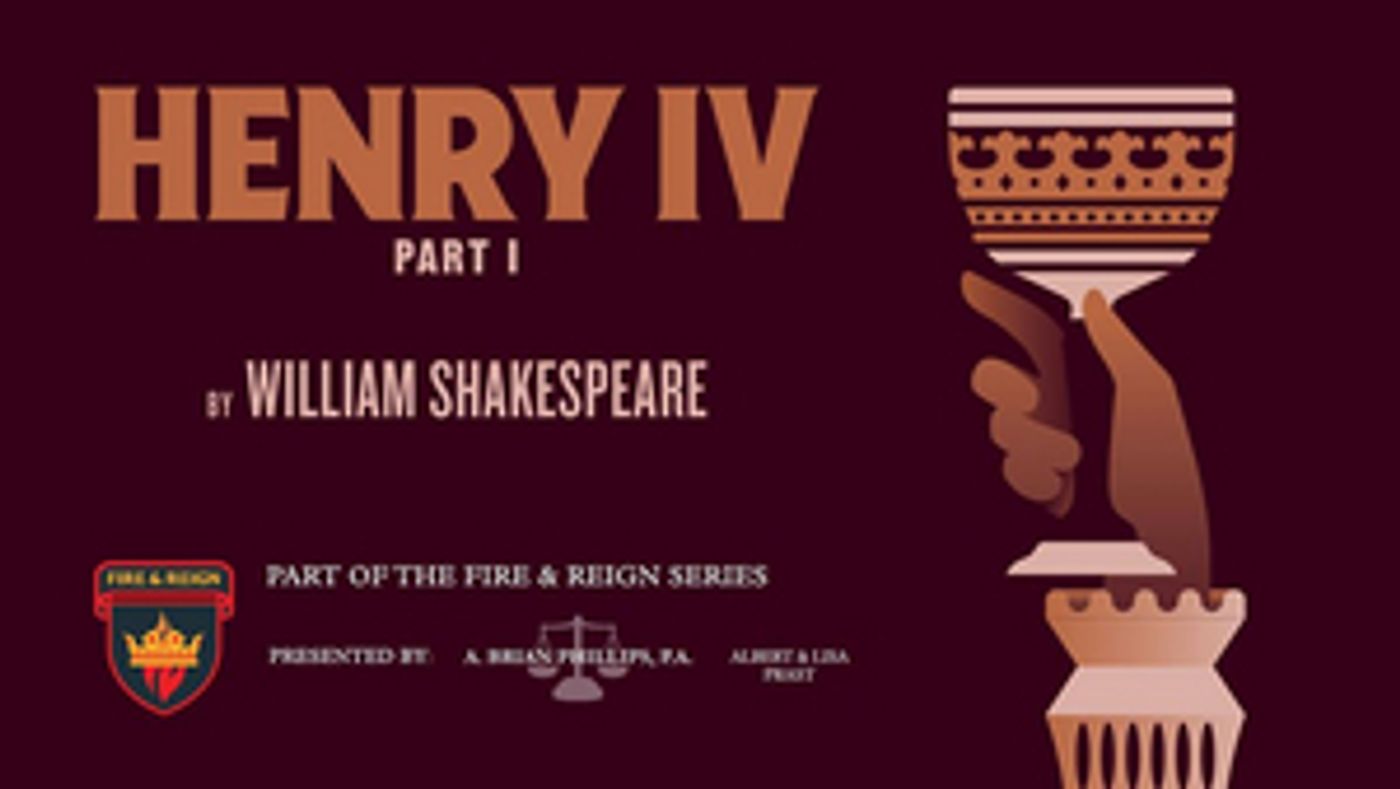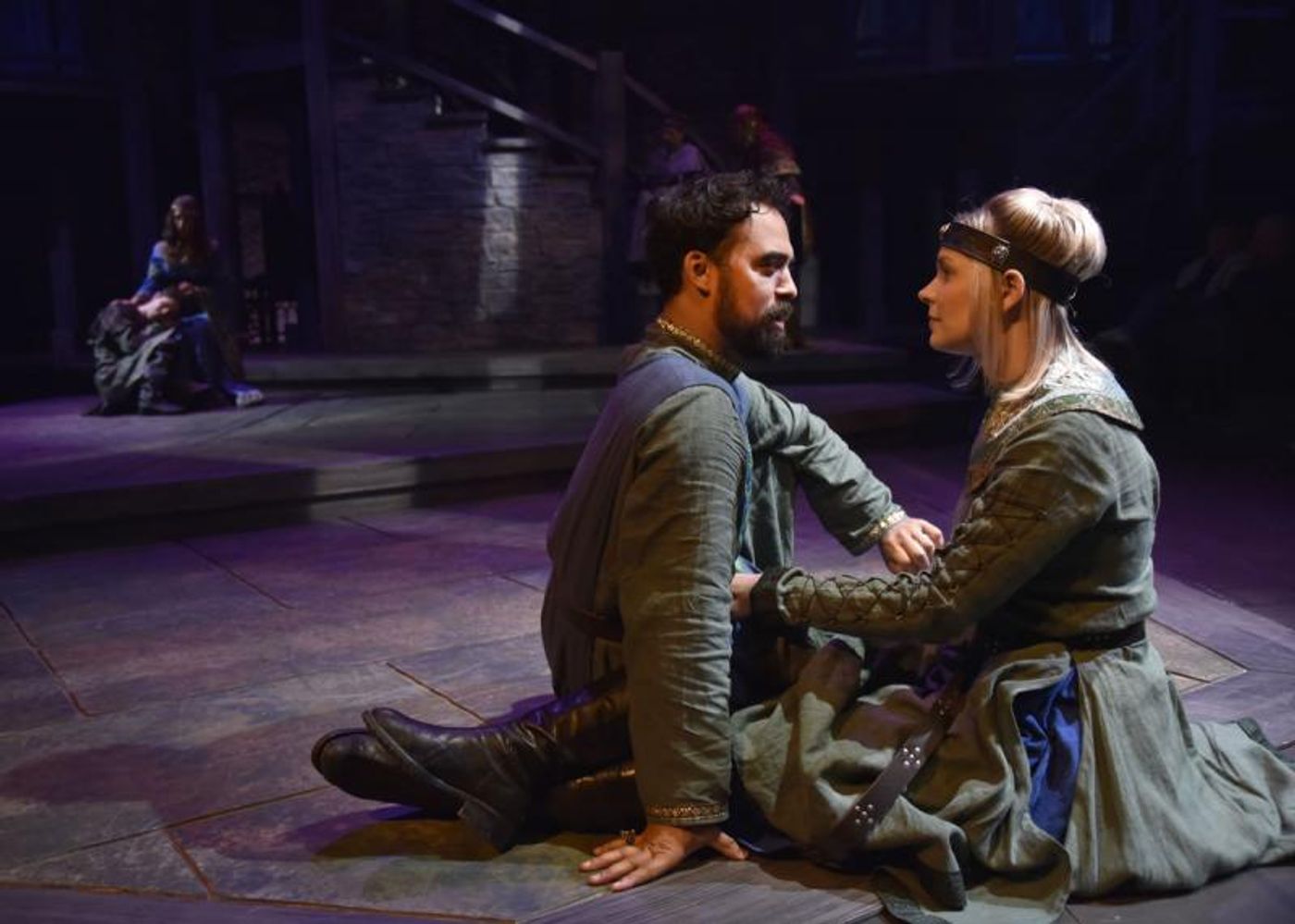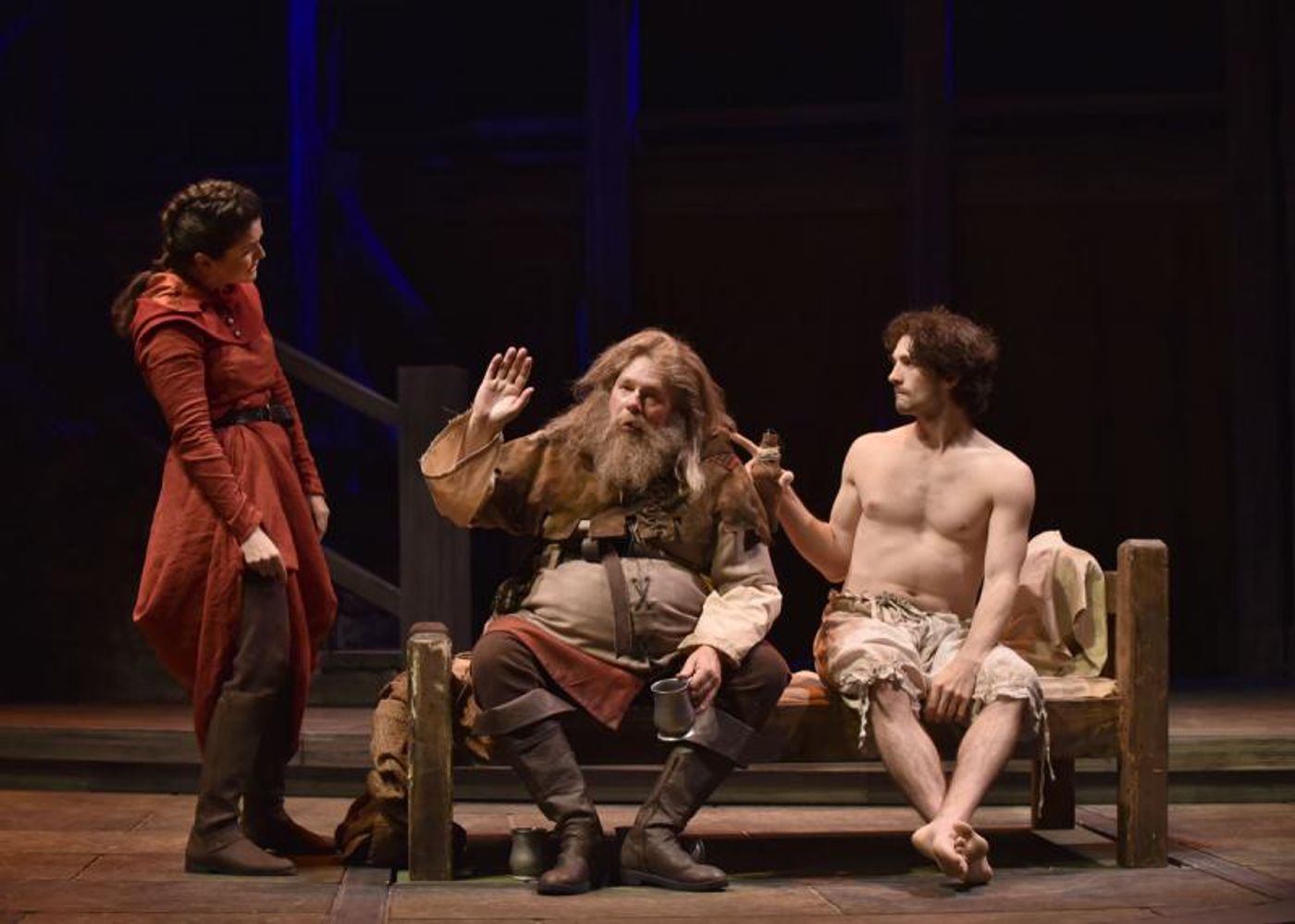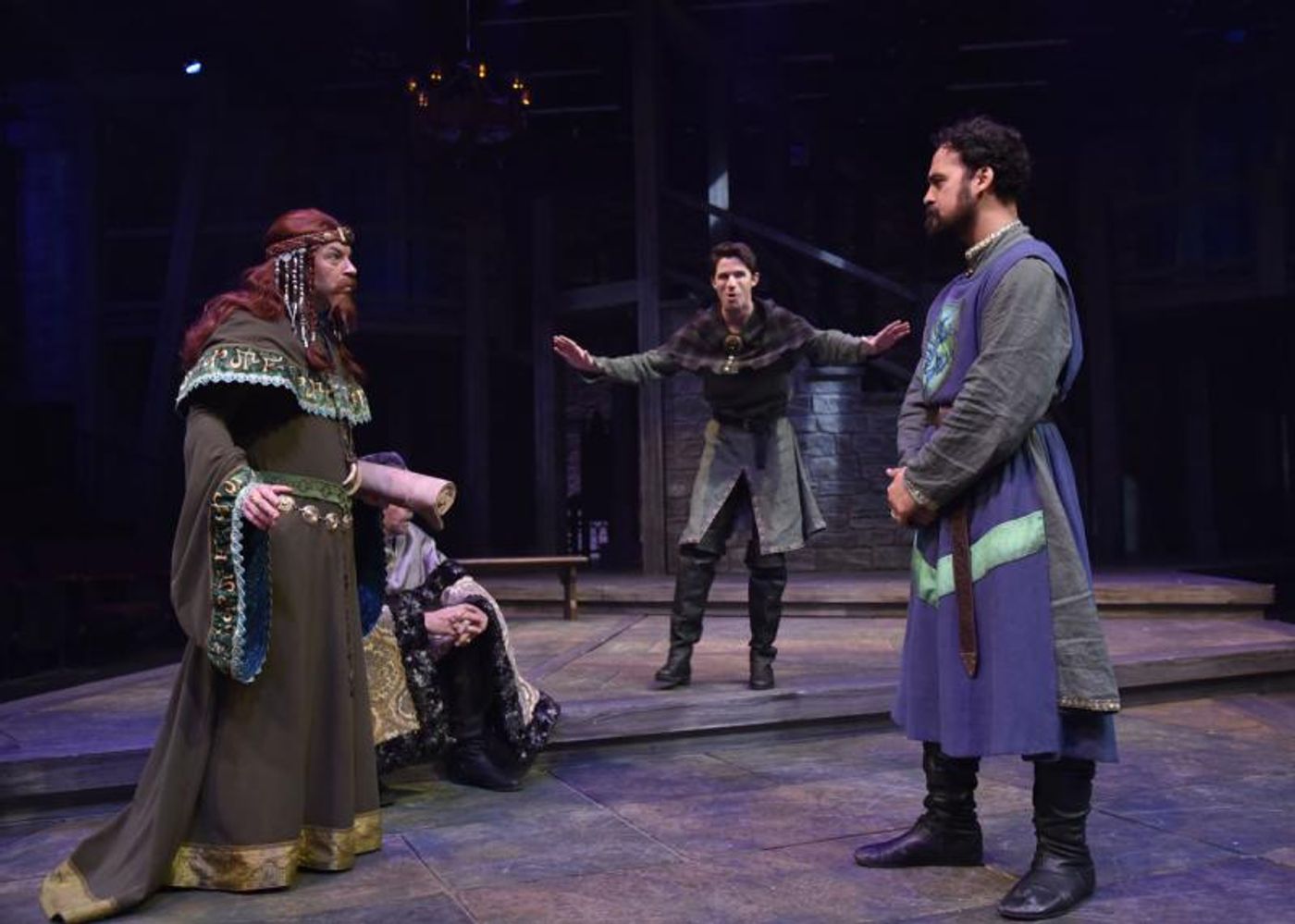Review: HENRY IV, PART 1 Sets 'Fire' to the 'Reign' at Orlando Shakes

A few weeks back, I attended the opening night of The Three Musketeers at Orlando Shakes. I marveled, in particular, at a rotating stage and staircase designed by Bert Scott. The way the production team used that stage always impressed me. Imagine my delight when I came back to Orlando Shakes for the opening weekend of HENRY IV, PART 1 and saw that same exact stage now being used to represent 1492 England rather than 1628 France. Part of it is my fault, I didn't know they'd be using the same stage and assumed another theatre space at Orlando Shakes would house HENRY IV. But now knowing that this same space was used for two plays got the wheels in my head turning. It's a genius move on Orlando Shakes' part, creating a very fitting double-feature of entertainment. The same cast, the same stage, but two wholly different stories unfold.
Of course, thrifty reuse of set pieces is nothing new. For a brief diversion into my cinematic aficionado side, consider a staircase built for the 1950 Warner Bros. film Bright Leaf. Whoever designed that staircase probably didn't expect it to stay on the soundstage for the next thirteen years, getting redressed and reused across fourteen films. Yet the essence of the staircase, the design of it, and the purpose it served, made it as much an essential contract player on the Warner lot as the likes of Doris Day or James Garner. Most famously, it would gain cinema immortality as the staircase in 1958's Auntie Mame, with Rosalind Russell perched on the center as she exuberantly declares "Live! Live! Live! That's the message! Life is a banquet, and most poor suckers are starving to death!"

Although the Auntie Mame staircase and the Orlando Shakes staircase are years apart, I suddenly felt a kinship between them. The multi-purpose Auntie Mame staircase has been long gone, but its essence found its way back to the staircase at Orlando Shakes. Its versatile configuration allows it to serve two masters: the comedy of Three Musketeers and the drama of HENRY IV. And like the cast both shows share, the staircase is now also part of that company of players. It not only fulfills its role within the confines of its two plays, but, like Auntie Mame's aphorism, it lives. The theatre is our banquet, and this is the stairway that takes us three steps to Heaven. I know that the stairway will not be up there for long; other productions will strip that stage down to its bare essence once more and rebuild it into another world yet again. But for these brief shining moments in time, Auntie Mame's staircase lives.
That's a lot to say about one set piece. But truly, the set design between Three Musketeers and HENRY IV deserve this kind of mention. I've always been in awe of the sets at Orlando Shakes; when they mounted In the Heights a couple years back, the set they crafted seriously could have given the Broadway stage a run for their money. To see, within only a couple short weeks, the same set have an entirely different feel for both plays, is a testament to the genius of its design and the vision of its designer. Equally important, especially given the same work space, is the direction behind it all. Whereas The Three Musketeers was directed by Jim Helsinger, HENRY IV, PART 1 has a relative newcomer to Orlando Shakes: Carolyn Howarth, in her second season with the company. She needs to envision the space differently from Helsinger, whilst also ensuring her performers tackle their roles with a different sensibility than Musketeers. Within each role, I also found every HENRY IV performer now tasked with taking on someone that is a far cry from their Three Musketeers counterpart. It allows each of them, through the careful direction by Howarth, to show the range of their craft, as well as comment once again on the double-feature nature of both plays.

This actually is not the first time that Benjamin Bonenfant has played Prince Hal, as he previously took on the role at the Colorado Shakespeare Festival. With this kind of familiarity, he eases into the role of Hal like an pair of old slippers. Granted, I cannot truly judge Bonenfant's portrayal of Hal here compared to what he did at CSF, but I could still sense a greater comfort to Hal than to D'Artagnan, yet one that also kept a freshness to the role for any newcomers (like me) to his performance. Whereas D'Artagnan would act first, question later, Prince Hal is often more contemplative than that. A prototypical Hamlet, but with not as much emotional baggage.
Taking on the lead role in two plays at the same time surely would be difficult, I imagine. However, Bonenfant makes sure each role comes off unique from the other. The effectiveness of any performer is not just in their interpretation, but also how the audience responds to it and any inevitable comparisons the performace will draw. When I saw The Three Musketeers, Bonenfant's depiction of D'Artagnan felt very much a definitive portrayal for me compared to the likes of Chris O'Donnell (1993's Three Musketeers) or Logan Lerman (2011's Three Musketeers). Regarding a character like Prince Hal, there are less options for me to turn to. The only Shakespearean comparison I have is Kenneth Branagh's Henry V, which I saw just once, but too many years separate my viewing of that to Bonenfant's portrayal today. Likewise, Branagh's Hal is older than he would be in HENRY IV, PART 1, although the film does flashback to moments from that play.
A more closer assessment, albeit one a bit more removed from Shakespeare, would be Keanu Reeves' Scott Favor in My Own Private Idaho, Gus Van Sant's indie film loosely based on HENRY IV, and a personal favorite film of mine. It then becomes not so much a question of who played Hal best, but who embodies what that character means. For me, Bonenfant embodied it best. A reluctant ruler, one who shirks his responsibilities not because he's afraid of them, but because he knows how important they are. And his inevitable turn is the all-important life-changing decision that not only affects him, but everyone he knows. You don't really get that kind of conflict with Scott in My Own Private Idaho. He's a gay-for-pay rich boy who eventually goes back to daddy's fortune. Bonenfant's Prince Hal carries that weight in every scene, even when he's cavorting at a tavern. It's the unspoken part of acting that words on the page doesn't convey, but must be given from the performer.

I think that's why I've been so entranced by every performer's 180-degree turn between HENRY IV and The Three Musketeers. They have to not only commit two sets of "words on a page" to memory, but disparate characterizations in what those words will mean. As much as I love Bonenfant's turns in both D'Artagnan and Prince Hal, equally impressive are when a performer must take on two vastly different characters within the same play. Anne Hering does just that with her double duty in HENRY IV. She gender-switches up the Earl of Westmoreland whilst also servicing Prince Hal as Hostess Quickly. Unlike her Cardinal Richelieu of The Three Musketeers, Hering's Westmoreland is very loyal to the king, with no puppet-string politics at play here. Also, unlike Cardinal Richelieu, the nature of Westmoreland doesn't change much with the gender switch. Her advisory role plays out as one would expect, perhaps just the fault of the character and not Hering. I delighted in seeing her turn quickly (wait for it...) from regal and well-spoken to the more bawdy Hostess Quickly (there it is), who runs the Boar's Head tavern that Hal and Falstaff frequent. As Quickly, Hering helps provide a comedic foil to Falstaff, one who can hold her own while still having a few other tricks up her sleeve.
Perhaps in a bit of narrative irony, Quickly's tapster is Francis, played by Ben Cohen, who stole the show as King Louis XIII in The Three Musketeers. The Hering-Cohen dynamic is definitely played for laughs in HENRY IV, as opposed to the Machiavellian dramatics of The Three Musketeers. It's also a testament to Cohen that he can turn so easily from foppish Louis to dim Francis. There's a great moment when Falstaff is regaling the tavern with his (fabricated) fight in the woods. Everyone looks on in amazement as he embellishes every detail, but none more so than Cohen. Francis mostly hangs on every word of Falstaff's, but Cohen serves a look that plays both the impressed bewilderment and the lingering doubt. I half expected him to drop his tray in shock by the end of it.

Of course, Falstaff is perhaps the second biggest star of HENRY IV, and I don't mean that just literally. Shakespeare always wrote the part as a a fat and boastful man, someone who's too big for his britches, and not just because they don't fit. Philip Nolen, who is the otherwise diminutive but authoritative Monsieur de Treville, gets to chew the scenery as only Falstaff can. It's a part that allows him to use more of his jovial "Citizens of Hollywood" persona, lending a dash of Disney whimsy to the popular character. Some of Nolen's beats on the character reminded me, perhaps unintentionally, of a human-like Pumbaa from The Lion King. Nothing as juvenile as fart jokes (which would have been up the groundlings' alley at The Globe Theatre), but more that devil-may-care "Hakuna Matata" attitude that distracts his young charge from his duties.
Perhaps the most Disneyest comparison I can make, and one that couldn't have been made ten years ago, is Samantha Potak as the Earl of Douglas, leader of the Scottish rebellion. Potak's more gentle character, Anne of Austria, felt rather underused in The Three Musketeers. She more than makes up for this as the untamed Douglas. Regarding that Disney comparison, imagine if Merida from Pixar's 2012 film Brave were actually given a sword. Now, imagine her with two swords and a bone to pick with her neighbors. That's Potak's Douglas, offering a very refreshing turn on the character. She has more fun in Act Two than she does in the entirety of The Three Musketeers, flailing those swords as expertly as Xena, Warrior Princess.

Swordplay is a common theme for both The Three Musketeers and HENRY IV. The battles are spread apart appropriately between the two acts for The Three Musketeers, but HENRY IV saves it all for the second half of the night. Much of that first half is devoted to the drama of the piece: King Henry IV lamenting his son's choices, Prince Hal and Falstaff in the tavern, Hotspur plotting against them. By the second half, we're at the battlefields. The swish-swish clang-clang of it all keeps us entertained, but who's swishing and who's clanging furthers the story. As we see various couplings face off against each other, we know the stakes get raised with every subsequent pairing. By the end of the play, most anyone who knows Shakespeare's works will know how it ends. This is "Part 1" after all. But the thrill of watching it unfold is like turning the page for the next chapter in a book. We get the satisfaction of an ending for now, but we know that there are more to these characters that have yet to unfold.
Orlando Shakes is playing the long game with HENRY IV, as it's the middle act of a three-season "Fire and Reign" series that began last year with Richard II. This season, we'll see it continue with a "Bare Bard" production of Henry IV, Part 2 and a one-night-only reading of Henry V. Although it hasn't been announced, I'm hoping we'll see this same cast take on the other two plays this season. Even though I highlighted but a few here, this whole company of players have already wowed me in Musketeers and, again, add new layers to their HENRY IV interations, so it would be great to see them continue to evolve with their characters across the next two plays. Next year, the "Fire and Reign" enters its last season, as we see the Wars of the Roses unfold through Henry VI, Edward IV, and Richard III. Truth be told, of all the Shakespeare histories I've read, you're getting the best of "Fire and Reign" this season, as Henry IV and Henry V are the strongest of the plays. This particular production of HENRY IV kept me engaged and invested, thanks to such talented performers and a versatile set that, again, I cannot heap enough praises upon.

HENRY IV, PART 1 runs now through March 21. Tickets can be purchased online through www.orlandoshakes.org
Photo Credits by Tony Firriolo, used with permission.
Reader Reviews
Videos

